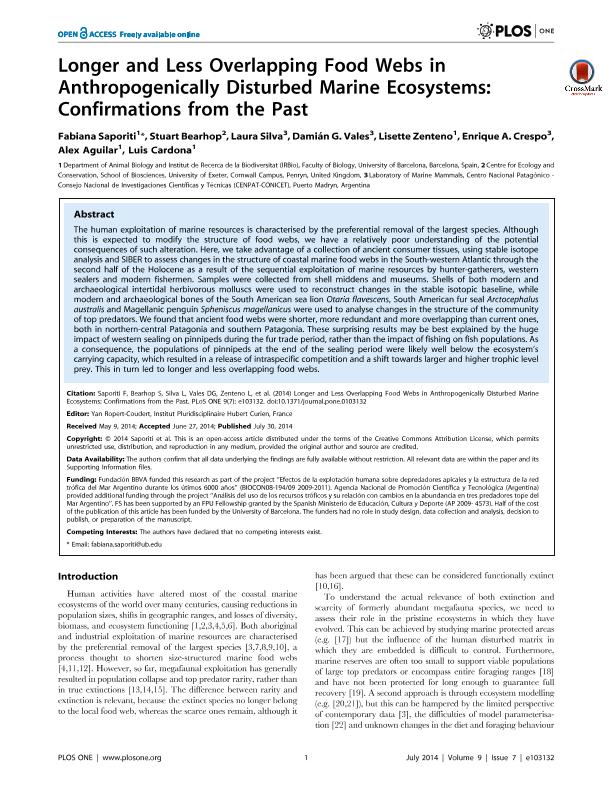Artículo
Longer and less overlapping food webs in anthropogenically disturbed marine ecosystems: confirmations from the past
Saporiti, Fabiana; Bearhop, Stuart; Silva, Laura Alejandra ; Vales, Damián Gustavo
; Vales, Damián Gustavo ; Zenteno, Lisette; Crespo, Enrique Alberto
; Zenteno, Lisette; Crespo, Enrique Alberto ; Aguilar, Alex; Cardona, Luis
; Aguilar, Alex; Cardona, Luis
 ; Vales, Damián Gustavo
; Vales, Damián Gustavo ; Zenteno, Lisette; Crespo, Enrique Alberto
; Zenteno, Lisette; Crespo, Enrique Alberto ; Aguilar, Alex; Cardona, Luis
; Aguilar, Alex; Cardona, Luis
Fecha de publicación:
07/2014
Editorial:
Public Library of Science
Revista:
Plos One
ISSN:
1932-6203
Idioma:
Inglés
Tipo de recurso:
Artículo publicado
Clasificación temática:
Resumen
The human exploitation of marine resources is characterised by the preferential removal of the largest species. Although this is expected to modify the structure of food webs, we have a relatively poor understanding of the potential consequences of such alteration. Here, we take advantage of a collection of ancient consumer tissues, using stable isotope analysis and SIBER to assess changes in the structure of coastal marine food webs in the South-western Atlantic through the second half of the Holocene as a result of the sequential exploitation of marine resources by hunter-gatherers, western sealers and modern fishermen. Samples were collected from shell middens and museums. Shells of both modern and archaeological intertidal herbivorous molluscs were used to reconstruct changes in the stable isotopic baseline, while modern and archaeological bones of the South American sea lion Otaria flavescens, South American fur seal Arctocephalus australis and Magellanic penguin Spheniscus magellanicus were used to analyse changes in the structure of the community of top predators. We found that ancient food webs were shorter, more redundant and more overlapping than current ones, both in northern-central Patagonia and southern Patagonia. These surprising results may be best explained by the huge impact of western sealing on pinnipeds during the fur trade period, rather than the impact of fishing on fish populations. As a consequence, the populations of pinnipeds at the end of the sealing period were likely well below the ecosystem's carrying capacity, which resulted in a release of intraspecific competition and a shift towards larger and higher trophic level prey. This in turn led to longer and less overlapping food webs.
Archivos asociados
Licencia
Identificadores
Colecciones
Articulos(CCT-CENPAT)
Articulos de CTRO.CIENTIFICO TECNOL.CONICET - CENPAT
Articulos de CTRO.CIENTIFICO TECNOL.CONICET - CENPAT
Citación
Saporiti, Fabiana; Bearhop, Stuart; Silva, Laura Alejandra; Vales, Damián Gustavo; Zenteno, Lisette; et al.; Longer and less overlapping food webs in anthropogenically disturbed marine ecosystems: confirmations from the past; Public Library of Science; Plos One; 9; 7; 7-2014; 1-13; e103132
Compartir
Altmétricas



